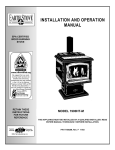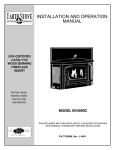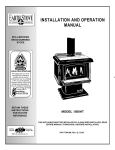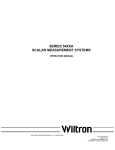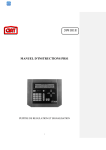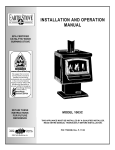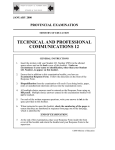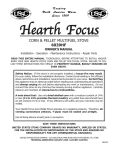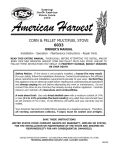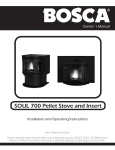Download Lennox Hearth 2800HT Karaoke Machine User Manual
Transcript
INSTALLATION AND OPERATION
MANUAL
EPA CERTIFIED
WOOD BURNING
FIREPLACE INSERT
RETAIN THESE
INSTRUCTIONS
FOR FUTURE
REFERENCE
MODEL 2800HT
THIS APPLIANCE MUST BE INSTALLED BY A QUALIFIED INSTALLER.
READ ENTIRE MANUAL THOROUGHLY BEFORE INSTALLATION.
P/N 775004M, Rev. J, 11/03
IMPORTANT WARNINGS
CAUTION: PLEASE READ THIS ENTIRE MANUAL BEFORE YOU INSTALL AND USE YOUR NEW ROOM
HEATER. FOR YOUR SAFETY, FOLLOW THE INSTALLATION, OPERATION AND MAINTENANCE INSTRUCTIONS EXACTLY, WITHOUT DEVIATION. FAILURE TO FOLLOW THESE INSTRUCTIONS MAY RESULT IN
PROPERTY DAMAGE, BODILY INJURY, OR EVEN DEATH. IF THIS APPLIANCE IS NOT PROPERLY INSTALLED,
A HOUSE FIRE MAY RESULT. CONTACT YOUR LOCAL BUILDING OR FIRE OFFICIALS ABOUT RESTRICTIONS
AND INSTALLATION INSPECTION REQUIREMENTS IN YOUR AREA.
1. If utilizing an older chimney, it must be inspected
for adequate serviceability. Refer to the heading
13.
Chimney Inspection on page 4.
2. Install only in masonry fireplaces, built to UBC
37 or ULC S628 standards or A factory built fireplace (built to UL 127 or ULC S610 standards).
3. The minimum clearances must be maintained for
all combustible surfaces and materials including;
furniture, carpet, drapes, clothing, wood, papers,
etc. Do not store firewood within this clearance
space. Failure to maintain clearances to all combustibles may result in a house fire.
4. This appliance requires a non-combustible fire14.
place hearth or hearth extension (see Floor Protection on page 4 for additional information).
5. Minimum ceiling height must be 7 feet (213 cm)
(measured from base of appliance to ceiling).
6. DO NOT CONNECT THIS APPLIANCE TO A
CHIMNEY FLUE CONNECTED TO ANOTHER APPLIANCE.
15.
7. Do not connect this appliance to air ducts or any
air distribution system.
16.
8. Do not install appliance in a sleeping room.
9. PREVENT CREOSOTE FIRE: Inspect and clean
chimney frequently. Under certain conditions of
17.
use, creosote buildup may occur rapidly. Inspect
chimney connector and chimney twice monthly
and clean if necessary. Using green or inadequately seasoned wood can greatly increase
creosote buildup. Use dry wood to minimize
18.
creosote buildup.
10. USE SOLID WOOD FUEL ONLY: This appliance
is approved for burning dry seasoned natural
wood only. CAUTION:
BURN UNTREATED
WOOD ONLY. DO NOT BURN GARBAGE OR
FLAMMABLE FLUIDS SUCH AS GASOLINE,
NAPHTHA OR ENGINE OIL.
19.
11. Never use gasoline, gasoline-type lantern fuel,
kerosene, charcoal lighter fluid, or similar liquids to start or "freshen up" a fire in this heater.
20.
Keep all such liquids well away from the heater
while it is in use.
12. DO NOT OVERFIRE: If heater or chimney con21.
nector glows, you are overfiring. Overfiring this
appliance could cause a house fire. Overfiring is
22.
a condition where the appliance is operated at
temperatures above its design capabilities.
Overfiring can be caused by improper installation, improper operation, lack of maintenance or
improper fuel usage. Damage caused from overPAGE 2
firing is NOT covered under the manufacturer's
limited warranty.
NEVER LEAVE AN UNATTENDED FIREPLACE
INSERT BURNING ON HIGH. Operation of the
fireplace insert with the primary air control at its
highest burn rate setting for extended periods
can cause dangerous overfiring conditions. The
primary air control should only be positioned at
the highest setting during start-up procedures
and for short duration. When leaving the fireplace insert unattended ensure that the primary
air control is set to the low or medium low
range.
The Start-Up Air Control must only be opened
(pulled out) during the start-up procedures.
CAUTION: OPERATION OF THE APPLIANCE
WITH THE START-UP AIR CONTROL IN THE
OPEN POSITION FOR EXTENDED PERIODS
CAN CAUSE DANGEROUS OVERFIRING CONDITIONS.
Use a metal container with a tight fitting lid to
dispose of ashes.
IN THE EVENT OF A COMPONENT FAILURE,
USE ONLY COMPONENTS PROVIDED BY THE
MANUFACTURER AS REPLACEMENT PARTS.
Burning any kind of fuel uses oxygen from the
dwelling. Be sure that you allow an adequate
source of fresh air into the room where the fireplace insert is operating (see Ventilation Requirements on page 5).
CAUTION: HOT WHILE IN OPERATION. An appliance hot enough to warm your home can severely burn anyone touching it. Keep children,
clothing and furniture away. Contact may cause
skin burns. Do not let children touch the appliance. Train them to stay a safe distance from
the appliance.
Do not operate this appliance without the firebox baffle plate properly installed.
Build fires directly upon the brick hearth inside
the fireplace insert. Do not use grates, irons or
any other method to elevate the fire.
See the listing label located on the back of fireplace (or see Safety / Listing Label on page 26).
SAVE THESE INSTRUCTIONS.
TABLE OF CONTENTS
Important Warnings .................................................2
CONGRATULATIONS ON THE PURCHASE OF
YOUR NEW WOOD BURNING FIREPLACE INSERT
MANUFACTURED BY LENNOX HEARTH PRODUCTS.
Testing / Listing, EPA, Using this Manual................ 3
Planning Your Installation ..................................... 4-7
When you purchased your new insert, you joined
the ranks of thousands of concerned individuals
whose answer to their home heating needs reflects
their concern for aesthetics, efficiency and our environment. We extend our continued support to
help you achieve the maximum benefit and enjoyment available from your new insert.
Installation .......................................................... 8-12
Product Features and Controls ..............................12
Care and Operation ......................................... 13-15
Recommended Fuel ...............................................16
It is our goal at Lennox Hearth Products to provide
you, our valued customer, with an appliance that
will ensure you years of trouble free warmth and
pleasure.
Maintenance ..................................................... 16-18
Troubleshooting ................................................ 19-20
Specifications..........................................................21
Thank you for selecting a Lennox Hearth Products
stove as the answer to your home heating needs.
Replacement Parts List..................................... 22-24
Sincerely,
All of us at Lennox Hearth Products
Optional Accessories ..............................................25
Safety / Listing Label...............................................26
EPA Label ...............................................................27
Ownership Records ................................................28
TESTING / LISTING
Model 2800HT has been tested to UL Standards
UL1482, ULC-5627 for installation into residential applications. The listing laboratory is OMNI Test Laboratories Inc, Beaverton, Oregon, Report #030-5-06-2.
EPA CERTIFICATION
This fireplace insert has been tested to rigorous emissions standard, and has been certified by the Environmental Protection Agency.
PACKAGING LIST
This appliance is packaged with an accessory package,
which contains the following:
One - Installation and operation instructions manual.
One - Warranty
One - Marble set (for stove top and ash lip).
One - Insulation pad and strips. Place pad under
top marble and strips under ash lip marble.
USING THIS MANUAL
Please read and carefully follow all of the instructions
found in this manual. Please pay special attention to the
safety instructions provided in this manual. The Homeowner’s Care and Operation Instructions included here
will assure you have many years of dependable and
enjoyable service from your appliance.
PAGE 3
PLANNING YOUR INSTALLATION
QUESTIONS TO ASK LOCAL BUILDING OFFICIAL
A correct installation is critical and imperative for reducing fire hazards and perilous conditions that can arise
when wood burning appliances are improperly installed.
The installer must follow all of the manufacturer's instructions.
FLOOR PROTECTION
This appliance requires a heat resistant noncombustible approved fireplace hearth or hearth extension. If the floor protection is to be stone, tile, brick,
etc., it must be mortared or grouted to form a continuous non-combustible surface.
The installation of a wood burning appliance must conform to local codes and applicable state and federal
requirements. Familiarity with these requirements before installation is essential. Important considerations to
discuss with local building officials include:
This protected area must extend a minimum of 18" (457
mm) to the front of the fuel door opening and 8" (203
mm) beyond both sides of the fuel door opening.
1.
HEARTH PROTECTION
Applicable codes (i.e. Uniform Mechanical Code,
State or Regional Codes)
Electrical codes: The blower system has a
flexible electrical cord that must be electrically
grounded per local codes or per electrical codes:
In USA, NEC, ANSI / NFPA 70-1987.
In Canada, CSA C22.1
WARNING: ELECTRICAL GROUNDING INSTRUCTIONS:
THIS
APPLIANCE
IS
EQUIPPED
WITH
A
THREE-PRONG
(GROUNDING) PLUG FOR YOUR PROTECTION AGAINST SHOCK HAZARD AND
SHOULD BE PLUGGED DIRECTLY INTO A
PROPERLY GROUNDED THREE-PRONG RECEPTACLE. DO NOT CUT OR REMOVE THE
GROUNDING PRONG FROM THIS PLUG. DO
NOT ROUTE POWER CORD UNDER OR IN
FRONT OF APPLIANCE.
8" USA
9½" (241 mm) –
CANADA
8" USA
9½" (241 mm) –
CANADA
CHIMNEY INSPECTION
The existing fireplace should be inspected by a local fire
marshal or qualified installer for adequate serviceability
prior to installing this appliance.
2. Local amendments?
3. Is a permit required - cost?
(You may wish to contact your insurance company
to ask if they require this).
4. Rooms where the installation is not allowed?
SMOKE DETECTORS
Since there are always several potential sources of fire
in any home, we recommend installing smoke detectors. If possible, install the smoke detector in a hallway
adjacent to the room (to reduce the possibility of occasional false activation from the heat produced by the
fireplace insert). If your local code requires a smoke
detector be installed within the same room, you must
follow the requirements of your local code. Check with
your local building department for requirements in your
area.
IMPORTANT – THIS APPLIANCE IS NOT APPROVED FOR INSTALLATION INTO A MANUFACTURED (MOBILE) HOME IN CANADA OR IN THE
USA.
18" (457 mm)
USA AND CANADA
Factory built fireplace (not approved in Canada): If
any portion of the chimney system shows signs of
structural or mechanical weaknesses, such as:
cracks, leaky joints, corroded or warped surfaces.
Look for obvious bulges in the lining, which may indicate the need to replace that section (use a bright
flashlight. Any faulty portion must be repaired or replaced prior to installing this appliance. Also, inspect
the attic to see that the chimney has proper clearance
to combustible framing members.
Masonry fireplace: The chimney should have no
cracks, loose mortar, other signs of deterioration, or
blockage. Any necessary repairs should be done by a
qualified mason.
If the existing fireplace flue system is dirty or has some
obstruction in it, clean it. A dirty chimney can cause
your insert to smoke when refueling, and can result in a
chimney fire. An oversized chimney may result in less
than optimum performance. Installations into a large
masonry chimney may require a liner to improve performance.
PAGE 4
PLANNING YOUR INSTALLATION
CLEARANCES
WARNING: IT IS VERY IMPORTANT THAT YOU
OBSERVE THE MINIMUM CLEARANCES. DO NOT
STORE FIREWOOD WITHIN THIS CLEARANCE
SPACE. FAILURE TO MAINTAIN CLEARANCES TO
ALL COMBUSTIBLES MAY RESULT IN A HOUSE
FIRE.
There are listed clearances for your fireplace insert,
which were determined in a Laboratory testing and
must be maintained.
Stove top to mantel:
Stove top to trim:
Stove side to trim:
Stove side to sidewall:
27" (686 mm)
16" (406 mm)
6" (152 mm)
6" (152 mm)
DRAFT REQUIREMENTS
The appliance is merely one component of a larger system. The other equally important component is the venting system. This is necessary for achieving the required
flow of combustion air to the fire chamber and for safely
removing unwanted combustion byproducts from the
appliance. If the venting system's design does not promote these ends, the system may not function properly.
Poorly functioning venting systems may create performance problems as well as be a safety hazard (i.e.
an oversized chimney may result in less than optimum
performance. Installations into a large, masonry chimney may require a liner to improve performance). A
draft test should read greater than .04' W.C. (inches
water column) and less than .08" W.C.
American National Standards Institute ANSI/NFPA 211-92,
draft 1-7: A chimney or vent shall be so designed and constructed to develop a flow sufficient to completely remove all
flue and vent gases to the outside atmosphere. The venting
system shall satisfy the draft requirements of the connected
appliance in accordance with the manufacturer’s instructions.
PROVIDE ADEQUATE AIR FOR COMBUSTION
In well insulated and weather tight homes, it may be
difficult to establish a good draft up your chimney. The
poor draft is caused by a shortage of air in the house.
To provide the needed air, crack a window on the windward side of the house.
VENTILATION REQUIREMENTS
THE FRESH AIR REQUIREMENTS OF THIS APPLIANCE MUST BE MET WITHIN THE SPACE WHERE
IT WILL BE INSTALLED.
For installation with a combustible mantel or top trim,
Part #16101 deflector must be installed.
Ventilation is essential when using a solid fuel burning
heater. The combustion process of this heater uses
oxygen from inside the dwelling and it may be necessary to open a window or install a vent to provide makeup air into a dwelling that is well insulated (modern construction standards have resulted in homes that are
highly energy-efficient and that allow little heat loss and
air transfer). Other appliances in the dwelling also contribute to removing air from the dwelling (i.e. clothes
dryers, exhaust fans, fireplaces, and other fuel burning
appliances). If the available fresh air delivery in the
dwelling is insufficient to support the demands of these
appliances, problems can result (i.e. excessive negative
pressure can develop in the dwelling which will affect
the rate at which this appliance can draft. See Draft Requirements on this page).
PAGE 5
PLANNING YOUR INSTALLATION
FACTORY BUILT FIREPLACES
(Not Approved In Canada)
In the USA, this appliance is approved for installation
into a listed factory built solid fuel burning fireplace (built
to UL 127 or ULC S610 standards). The fireplace firebox must accept the insert without modification other
than removing bolted or screwed together pieces such
as smoke shelf / deflectors, ash lips, screen or door
tracks and damper assemblies, that must be reinstalled
to restore the fireplace to its original operating condition
if the insert is removed and not replaced. The removal
of any part must not alter the integrity or outer shell of
the pre-engineered fireplace cabinet in any way.
Venting Requirements for factory built fireplace:
The fireplace damper must be secured in the open position. This appliance requires the use of a 6” (152 mm)
diameter flex or rigid, UL1777 listed 2100° HT liner or
equivalent. The liner must extend from the flue outlet of
the appliance to termination. Do not face seal over fireplace chimney cooling air systems. Offsets can be handled with an offset adapter (it aligns starter pipe with
fireplace flue). For more information on the offset
adapter, see pages 10 and 26.
WARNING: DO NOT SUBSTITUTE THE HEAT
RATED 2100°HT LINER WITH ANY OTHER TYPE
LINE OR A FIRE MAY RESULT CAUSING PROPERTY DAMAGE, PERSONAL INJURY OR LOSS
OF LIFE.
PAGE 6
Factory Built Fireplace Installation
PLANNING YOUR INSTALLATION
MASONRY FIREPLACES
This appliance is approved for installation into a masonry fireplace built to UBC 37 or ULC S628 standards.
Do not remove brick or mortar form the masonry fireplace to accommodate this appliance. If the fireplace
has been modified to accommodate the fireplace insert,
a metal tag documenting what was modified must be
attached to the fireplace (as required by Clause 5.1.11
it must be secured using screws or nails to the fireplace, in a location readily visible should the fireplace
insert be removed). The lettering shall not be less than
5 mm high.
Metal Tag
THIS FIREPLACE HAS BEEN ALTERED TO ACCOMMODATE A FIREPLACE INSERT AND
SHOULD BE INSPECTED BY A QUALIFIED PERSON PRIOR TO RE-USE AS A CONVENTIONAL
FIREPLACE
Offsets
Offsets can be handled with an offset adapter (it aligns
starter pipe with fireplace flue). For more information
on the offset adapter, see pages 10 and 26.
FIREPLACE CHIMNEY MAXIMUM SIZE TO ENSURE
PROPER DRAFT – USA ONLY
Note: Installations in Canada require a full length liner.
The fireplace insert flue size is 6 inches (152 mm) diameter, which is approximately 28 square inches (711
square mm), the minimum. The maximum flue size
should be no more than (3) three times the cross sectional area of the size of the fireplace insert flue collar.
In this case, that would be no larger than a 10 inch (254
mm) diameter stack (area = approx. 85 sq. inches [216
sq. cm]).
Note: Formulas for calculating Area:
IMPORTANT: Any opening between the masonry of
the fireplace and the facing masonry must be permanently sealed.
USA Requirements / Masonry Fireplaces - The fireplace damper must be secured in the open position. In
the USA, a flue extension past the fireplace header is
required as a minimum. A preferred installation is a
positive flue connection (sealing the throat of the chimney). This appliance requires the use of a 6” (152 mm)
diameter flex or rigid single wall pipe, minimum 24 / 25
MSG black or blued steel connector pipe (stainless
steel recommended).
Canada Requirements / Masonry Fireplaces - – This
fireplace insert must be installed into an approved solid
fuel Masonry fireplace only (installation into a factory
built fireplace is not approved). The fireplace damper
must be secured in the open position. The fireplace insert must be installed with a continuous chimney liner of
6” / 152 mm diameter extending from the fireplace insert to the top of the chimney. The chimney liner must
conform to the Class 3 requirements of CAN / ULC –
S635, Standard for Lining Systems for Existing Masonry
or Factory-Built Chimneys and Vents, or CAN / ULC –
S640 Standard for Lining Systems for New Masonry
Chimneys.
Calculating area of a circle:
π x r 2 = Area (π = 3.1416, r = 1/2 diameter)
To calculate area of square or rectangle:
Width x Depth = Area
Notes:
It may be necessary to use a full-length liner to
achieve adequate draft for the appliance. A draft
gauge should read more than .04 W.C.I, but less than
.08 W.C.I. for optimum performance.
This appliance is approved for all heatform style
fireplaces (masonry fireplace with a metal firebox liner).
PAGE 7
INSTALLATION
FIREPLACE INSTALLATION
•
USA only - All masonry fireplace installations require a minimum positive flue connection using a
block-off plate or a positive seal past the bottom of
the chimney flue tile liner. In Canada, a full reline
is required.
•
Measure fireplace size to make certain the insert
will fit before considering the installation.
CHIMNEY
TERMINATION CAP
ENSURE CHIMNEY
IS SOUND
MASONRY FIREPLACE:
USA APPROVED LINER –
6” DIA. FLEX OR
RIGID 24/26 MSG BLACK OR
BLUED STEEL PIPE OR 2100°
HT LINER
CANADA APPROVED LINER –
S635 FLUE LINER
FACTORY BUILT (ZC)
FIREPLACE (USA ONLY) –
APPROVED LINER – 6” DIAMETER 2100° HT LINER
REMOVE FIREPLACE DAMPER OR
SECURE OPEN
MASONRY FIREPLACE REQUIREMENTS - This appliance may be installed in a masonry fireplace with an opening height of at least 21 inches (533 mm) using Masonry
Fireplace Kit P/N 14M75. Installation into a masonry fireplace with an opening of 24” (610 mm) or higher does not
require this header insulation kit. See page 26 for ordering
information.
Masonry Fireplace Minimum Firebox Dimensions
Minimum size required for fireplace firebox (recessed
area into fireplace):
Height
Width at front of fireplace
Width at back of fireplace
Depth into fireplace
21”
24 1/4”
23 1/4”
15 3/4”
(533 mm)
(616 mm)
(591 mm)
(400 mm)
FACTORY BUILT FIREPLACE REQUIREMENTS – Note:
In Canada, installation into a Factory Built Fireplace is not
approved. When installing the 2800HT into a "high dome"
or "low profile" type factory built fireplace (ZC), a ZC Fireplace kit is required (kit consists of components to insulate
and allow for heat dissipation). See page 26 for ordering
information.
Factory Fireplace Minimum Firebox Dimensions
Minimum size required for fireplace firebox (recessed
area into fireplace):
Min. unrestricted front opening:
Min. inside firebox height at flue opening:
Width at front of fireplace
Width at back of fireplace
Depth into fireplace
21”
22”
24 1/4”
23 1/4”
15 3/4”
(533 mm)
(559 mm)
(616 mm)
(591 mm)
(400 mm)
Side View of Typical Factory-Built Fireplaces
Do not face seal over
chimney cooling air system.
PAGE 8
INSTALLATION
POWER CORD CHANGEOVER
DANGER: Risk of electrical shock. Disconnect
power before servicing appliance. Do not route
power cord under or in front of appliance.
To change the power cord from one side of insert to the
other, perform the following steps:
1. Ensure power cord in NOT plugged in.
2. Remove the louver blower panels on each side of
fuel door as follows. Each panel is held in place by
two ¼” (7 mm) head screws. Using a ¼” (7 mm)
socket or nut driver, remove the screws
3. Remove panels by pulling them outward slightly then
forward.
4. Locate terminal block on right side of appliance.
Write down the locations where the black, white and
green leads from the power cord are attached to the
terminal block. Disconnect these three wires then reinstall them onto the terminal block on the left side of
appliance in the same corresponding positions (as
you had written down).
5. Reinstall panels.
BAFFLE PLATE
This appliance has a very heavy (60 lbs [27 kg]) 3/8" (9.5
mm) thick steel baffle that is installed directly above the
secondary air tubes in the firebox. To inhibit the baffle
plate from shifting during shipment, a packing block is
installed at the factory (see illustration below). The packing block needs to be removed prior to burning your insert. During installation, the baffle may slide forward, and
must be repositioned (pushed to the back) in order for
the insert to operate properly. When in its proper position, the rear flange of the baffle plate should be flush to
the back wall of the firebox.
MARBLE
Marble is a natural product and therefore each piece will
have its own unique character. Marble can be scratched
so care should be taken to avoid putting heavy or rough
objects (trivet / steamers) on the surface. Do not install
the marble before curing the paint.
The ceramic fiber blanket and cerawool strips provided
with appliance must be placed under the marble to insulate it from the high temperatures on top of the firebox.
Do not place the marble directly on the top metal surface
of the stove or it will crack.
INSTALLATION STEPS
1. Remove all ashes from the fireplace.
2. Remove all materials inside the insert and set them aside.
3. Remove the three-piece surround assembly (face shield)
and attach insulation material provided using a nonflammable adhesive (i.e. RTV Silicone, rated 570° F).
4. Use a large piece of cardboard or other protective material
and place it in front of the fireplace to protect floor or carpet
during installation.
5. Remove the insert from its wood pallet by removing the
screws.
6. Prepare chimney connection system as specified for masonry or zero clearance fireplaces.
7. Set the insert on the protective cardboard laid out in front of
the fireplace centered in front of the fireplace opening.
8. (Masonry Fireplace) Slide insert into the fireplace far enough
to attach the starter pipe or positive flue connection (a minimum of a 6" (152 mm) starter pipe extending past the
header is required). See * note, page 11.
9. (Factory Built Fireplace – USA only) Slide insert into the fireplace far enough to attach connector to flue outlet. See *
note, page 11.
PAGE 9
INSTALLATION
10. Offsets can be handled using an offset adapter (it
aligns starter pipe with flue. See Offset Adapter,
page 26 for ordering information). Do not push insert
in completely until surround assembly is installed.
Care should be used to ensure that this adjustable
connector is oriented so it does not angle downhill
when positioned on the flue outlet on top of insert.
12. Reaching over the top of the insert, install the starter
pipe in the stove flue, or attach the positive flue connection to the insert. See * Note, page 11.
CORRECT
CORRECT – Level
or even. Slightly up
at the outbound
end is better.
WRONG
WRONG – This may
produce a problem
of smoking during
refueling, or poor
chimney draw.
11. If the floor of the fireplace is lower than the hearth,
leveling bolts will need to be installed (not included
with the hardware. Use a 3/8” (10 mm) bolt with 2
nuts). The bolt length should be at least 1” (25.4 mm)
longer than needed. Locate the leveling bolt brackets
on the sides of the insert in the back. Install the 2
leveling bolts with nuts and adjust length as needed.
PAGE 10
INSTALLATION
SURROUND ASSEMBLY
POSITIVE FLUE CONNECTION FOR MASONRY FIREPLACE
IMPORTANT: Do not face seal over chimney
cooling air system on superior brand or any
brand fireplace which is designed with the
chimney cooling air system.
Note: Be sure the damper is locked in the open position.
13. Pull the insert slightly forward to its desired
position; attach the face shield using the surround clips and hardware as shown. The fiberglass insulation strips should be secured
along the top and sides (step 3). Assemble
the gold-tone trim using the 2 inside corner
brackets. Attach trim to the face shield and
stove.
A Professional should inspect chimney prior to installation to determine if any repairs are necessary or if a chimney reline is necessary.
The fireplace damper must be secured in the open position. If this is
not possible, it will be necessary to remove the damper. Installation
into a masonry fireplace requires as a minimum of a flue extension
past the header. This can be accomplished by one of the following
methods:
Install 6" (152 mm) smoke pipe if the chimney is located directly
above the insert flue outlet.
(or) Install 6" (152 mm) flex pipe to achieve the same result.
Push the appliance back until face shield insulation is compressed against the fireplace front,
forming a tight seal. Test for air leaks by holding a candle around edge of face shield to see
if smoke is pulled into fireplace.
*Note: Preferred method of attaching connector
to flue outlet is to install two L-Brackets (1” [25.4
mm] angle bracket, 3/4” [19 mm] wide) on opposite sides of the flue outlet: Use self-tapping
screws to secure in place. Cut a ½” (13 mm)
(height) and ¾” (19 mm) (width) notch in the front
of connector (pipe, liner or adapter that will attach
to flue outlet). Install connector into flue outlet and
secure to angle brackets using machine screws.
Seal around connection with furnace cement.
Use an offset adapter (see page 26) to handle offsets. This part is
available through your dealer.
PAGE 11
INSTALLATION
PRODUCT FEATURES AND CONTROLS
POSITIVE FLUE CONNECTION FOR MASONRY
FIREPLACE (continued)
BLOWER SYSTEM
The 500-CFM room air circulation blower system comes
equipped with a variable speed control (rheostat). The blower
system can be operated manually or set to operated automatically (so the blowers will turn on when the insert is hot and turn off
when the insert is cool). See Care and Operation Section –
Blower System on page 16.
A preferable installation is the positive flue connection
(a positive seal between the flue extension and the
chimney). This can be achieved by using a filler plate.
A filler plate can be made by making a cardboard pattern to fit the fireplace throat. Lay the pattern on 22
gage steel, add 2 inches (51 mm) to each side, and
cut. Snip corners and bend front lip up and sides and
back down. Cut an opening for the flue. Attach filler
plate with masonry screws.
Blower System Controls
Located on right side of door at bottom of panel.
Filler Plate
The starter pipe extends through the filler plate, past
the damper and into the existing chimney system.
Small air leaks should be sealed with high temp fiberglass or ceramic insulation.
PRIMARY AIR CONTROL
The primary combustion air delivery is controlled by the primary air control draft module (The control handle is located
below the fuel door in the center). The heat output can be controlled by pushing the handle in for a higher burn rate or pulling
it out for a lower burn rate. The fuel, the amount of heat and
burn times desired, the type of installation are all variables that
will affect the control setting. The same control settings in a
variety of installations will produce different results. You will
need to try different settings so you can learn how much heat to
expect and how long the fire will burn.
START-UP AIR CONTROL
The start-up air control provides additional air delivery to assist in
establishing a draft in a cold flue system (The control handle is
located below the fuel door on the left). From a cold start, approximately 10 minutes in the open position is all that is required
to achieve a stable burn.
PAGE 12
CARE AND OPERATION
GOLD DOOR
The doorframe is plated with 24-karat industrial grade gold
and requires curing to harden the gold. Once it is cured it
will never tarnish. Prior to burning this appliance the doorframe should be cleaned thoroughly with a good window
cleaning solution and a soft cloth. Do not use any metal
polishes or abrasives to clean the gold surface. Any oils or
fingerprints left on the gold could become permanent
blemishes if the stove is burned prior to their removal. After the first few fires, the gold will cure. The ¾” (19 mm)
diameter door rope gasket is made of highly durable high
temperature resistant material. It must be kept in good
condition. Do not leave the stove burning with the door
ajar or open. Leaving the door ajar or open while the stove
is burning will cause excessive heat build up in the stove
(overfiring) and could ignite surrounding combustibles as
well as damage the stove (such damage is not covered by
the manufacturer's warranty).
DOOR OPERATION
CAUTION: WHEN OPENING THE DOOR, DO NOT EXTEND IT BEYOND ITS NORMAL TRAVEL. OVEREXTENDING THE DOOR TO A FURTHER OPEN POSITION CAN PUT EXCESSIVE STRESS ON HINGE AREA
OF DOOR AND HINGE PINS AND MAY RESULT IN
BREAKAGE.
The door handle assembly is used to open and close the
fuel door assembly as follows:
To open the fuel door - Rotate the coil handle from the
6:00 position toward the 9:00 position, until door releases
(see illustration below).
To close the fuel door - Push door closed with the handle positioned in the 9:00 position. While pressing in, rotate the handle to the 6:00 position.
GLASS
The glass is a super heat resistant ceramic that withstands continuous temperatures up to 1390° F. This temperature is well beyond the temperatures in which you
operate your fireplace insert.
This appliance is designed to provide a flow of air over the
inside of the glass, where along with high heat helps keep
it clean. When operating the fireplace insert on low for
extended periods of time, the glass may get dirty. A short,
hot fire (15 - 20 minutes) will help clean off much of the
normal buildup (see Troubleshooting, pages 19-20). A
commercial glass cleaner designed for fireplace inserts is
recommended for cleaning.
The glass should be cleaned thoroughly with glass
cleaner and a soft cloth BEFORE the fireplace insert
is burned.
DOOR GASKET
The door gasket must be kept in good condition. Do not
leave the stove burning with the door ajar or open. Leaving the door ajar or open while the stove is burning will
cause excessive heat build up in the stove (overfiring) and
could ignite surrounding combustibles as well as damage
the stove (such damage is not covered by the manufacturer's warranty).
BREAK-IN PERIOD
Your fireplace insert finish is a high temperature paint that
requires time and temperature to completely cure. We recommend that you ventilate the house during the initial
burns. The paint emits non-toxic odors during this process.
KEEP YOUR HOUSE WELL VENTILATED DURING THE
CURING PROCESS TO PREVENT ACTIVATION OF
YOUR HOME SMOKE DETECTOR.
The paint manufacturer recommends three burn cycles to
cure the paint. The first two burns should be low heat, approximately 250°F., for 20 minutes each, using paper and
light kindling.
After each 20-minute burn, allow the appliance to cool completely. The third burn should be at least medium high or
about 450°F. for 45 - 60 minutes. The paint will become soft
and emit non-toxic haze during these burns. Keep the area
well ventilated.
As the paint cures it will become slightly lighter in color.
Eventually the entire surface will become an even color.
Once the paint has been softened and cooled two or three
times, it will harden. Do not turn on a blower during the
curing process.
Do not place anything on the fireplace insert surface until
the paint is completely cured. Do not attempt to repaint
the fireplace insert until the paint is completely cured. If
the surface later becomes stained or marred, it may be
lightly sanded and touched up with spray paint from the
same paint manufacturer (See Maintenance – Small Area
Paint Touch-up, page 16). Paint is available at your local
authorized Lennox Hearth Products dealer. Never attempt
to paint a hot stove.
PAGE 13
CARE AND OPERATION
AIR DRAFT CONTROLS
This appliance has two combustion air controls located
under the hearth extension. The control on the left is the
Start-Up Air Control. The control in the center is the Primary Air Control.
Start-Up Air Control
To provide sufficient combustion air to achieve a clean
burn as quickly as possible, the 2800HT supplements its
primary air with a separate "Start-Up" supply. This control should be used only when starting a fire or when
refueling. The start up air enters the stove at the rear of
the firebox and is controlled by the Start-Up Air Control
rod on the left.
From a cold start, approximately 10 minutes in the open
position is all that is required to achieve a stable burn.
CAUTION: OPERATION OF THE APPLIANCE WITH
THE START-UP AIR CONTROL IN THE "OPEN" POSITION (PULLED OUT) FOR EXTENDED PERIODS,
WASTES FUEL AND CAN CAUSE DANGEROUS
OVERFIRING CONDITIONS.
PRIMARY AIR CONTROL
Once the fuel load is well ignited, the Primary Air Control is
all that is needed to vary the burn rate in the insert. Push in
for a high burn rate; pull out for a slower burn rate.
USE CONTROL SETTINGS THAT WORK FOR YOU
The fuel, the amount of heat you want, the type of installation you have and how long you wish the fire to burn
are all variables that will affect the control setting. The
same control settings in a variety of installations will produce different results.
HOW TO START AND MAINTAIN A FIRE
1. Set the primary air control to the open position (push
in).
2. Set the start-up air control to the open position (pull
out).
3. Build a fire directly on the firebrick covering the bottom of the stove.
a. Place two or three loosely crumpled sheets of
newspaper in the insert firebox.
b. Add a small amount of dry kindling randomly on
the top of the newspaper.
c. Place one or two more loosely crumpled newspapers on top of the kindling and light the bottom
paper first, then light the top paper.
4. Once the kindling is ignited and burning on its own,
close the fuel door. The upper fire should help preheat the chimney and create an effective draft while
the lower fire ignites the kindling.
5. When the kindling is burning well, add increasingly
larger pieces of wood until the fire is actively burning
and a coal bed develops. By keeping both air controls open for approximately 10 minutes, the fuel and
the insert will quickly come up to ideal operating temperatures producing the highest combustion efficiency and least emissions.
6. Close the start-up air control (push in).
CAUTION: THIS CONTROL SHOULD ONLY BE
USED DURING START UP AND REFUELING.
7. Set the primary air control to the desired setting. The
insert will now provide clean, efficient and safe heat
for your home.
REFUELING
To refuel the insert, first move the primary air control to
high. Let the fire "liven up" for about one minute. Open
the fuel door about 1/2" (1 cm) and hold in this position
about 30 seconds or until insert is drafting well. Open
the door and add wood. If the fire or coal bed is almost
depleted and a full load of cordwood is added, it may be
necessary to open the start-up air control to re-establish
a lively fire. The use of start-up air should only be used
for a short period.
NOTE: After refueling and the wood is burning at a
brisk rate, reset the primary air control to the desired
position and close the start-up air control.
Familiarize yourself with your fireplace insert by trying
different settings so you can learn how much heat to
expect and how long the fire will burn. It may take a
week or two to learn but your patience will be rewarded
by the warmth and pleasant satisfaction that only a
wood fire can provide.
PAGE 14
CARE AND OPERATION
WIRING DIAGRAM
BLOWER SYSTEM
The Blower System consists of a ON / OFF
rocker switch, a variable speed blower speed
control switch (rheostat) located on the right
side panel, a thermally activated switch (fan
disc) and 4 axial blowers.
When starting a fire, leave the blower system
off until the insert is thoroughly heated (approx.
30 minutes after start up).
The blowers can be operated in one of the following manners:
Auto: Turn rocker switch to the off position (
“O” = off, “—“ = on). Turn the rheostat to the on
position by rotating the rheostat dial clockwise
until it clicks. When the insert warms up (110°
F), the blower will automatically turn on (adjust
rheostat dial to the desired speed setting).
When the insert cools down (90° F), the blowers will automatically turn off.
Manual: Turn rocker switch to the on ( — )
position and adjust rheostat dial to the desired
speed. The blowers will have to be manually
turned off by rotating the rheostat dial counterclockwise until it clicks.
BLOWER SPECIFICATIONS: 115 V, 60 Hz,
two axial blowers - .42 amps each, 125 CFM
each. Blower system has a flexible electrical
cord that must be electrically grounded per local codes or NEC, ANSI / NFPA 70-latest edition. Do not route the power cord under or in
front of the appliance.
Blower System Controls
Located on right side of door at bottom of panel
POWER FLOW DIAGRAM
CAUTION: BURNING THE INSERT AT A HIGH BURN RATE
FOR EXTENDED PERIODS WITHOUT RUNNING THE BLOWERS CAN CAUSE EXCESSIVE TEMPERATURES RESULTING
IN OVERFIRING DAMAGE TO THE APPLIANCE. EXCESSIVE
HEAT WILL CAUSE THE PROPELLERS ON THE BLOWERS TO
MELT. IF THIS OCCURS, REPLACE PROPELLERS AND REVIEW THESE INSTRUCTIONS FOR PROPER OPERATION
(PROPELLER PART / CATALOG #410-25-3. SOME PEOPLE
PREFER METAL PROPELLERS, WHICH ARE AVAILABLE
THROUGH GRAINGER, STOCK #2C953. BE ADVISED THAT
THESE ARE NOISIER THAN STANDARD PLASTIC BLADES).
OVERFIRING DAMAGE IS NOT COVERED UNDER THE 5 YEAR
PRORATED WARRANTY.
WARNING: THIS APPLIANCE IS EQUIPPED WITH A BLOWER
SYSTEM WHICH HAS A FLEXIBLE ELECTRICAL POWER
CORD WITH A THREE-PRONG (GROUNDING) PLUG FOR
YOUR PROTECTION AGAINST SHOCK HAZARD AND
SHOULD BE PLUGGED DIRECTLY INTO A PROPERLY
GROUNDED THREE-PRONG RECEPTACLE PER LOCAL
CODES OR NEC, ANSI / NFPA 70 - LATEST EDITION. DO NOT
CUT OR REMOVE THE GROUNDING PRONG FROM THE
POWER CORD PLUG. DO NOT ROUTE POWER CORD UNDER
OR IN FRONT OF APPLIANCE.
PAGE 15
FUEL
MAINTENANCE
BURN RECOMMENDED FUEL
This appliance is approved for use with wood only. Use
only natural dry untreated wood (see Important Warnings, page 2, #10). Do not burn particleboard scraps or
pressed logs using bonding agents because they can
produce conditions which will deteriorate metal. Green or
uncured wood does not work well as fuel, and can cause
increased creosote buildups. The value of green wood as
a source of heat is limited. Do not overload or use kindling wood or mill ends as primary fuel as this may cause
overfiring. Overfiring is a condition where excessive temperatures are reached, beyond the design capabilities of
the stove. The damage that occurs from overfiring is not
covered under the stove warranty.
SEASONING GUIDE
Softwoods – 6 months to 18 months
Hardwoods – 12 months to 24 months
WARNING: BURNING IMPROPER FUEL (I.E. CHARCOAL) CAN RESULT IN CARBON MONOXIDE POISONING WHICH MAY LEAD TO DEATH!
CARBON MONOXIDE POISONING - EARLY SIGNS
OF CARBON MONOXIDE POISONING RESEMBLES
THE FLU WITH HEADACHES, DIZZINESS, OR NAUSEA. IF YOU HAVE THESE SIGNS, GET FRESH AIR
AT ONCE! HAVE THE HEATER INSPECTED BY A
QUALAFIED SERVICE TECHNICAN. SOME PEOPLE
ARE MORE AFFECTED BY CARBON MONOXIDE
THAN OTHERS.
THESE INCLUDE PREGNANT
WOMEN, PEOPLE WITH HEART OR LUNG DISEASE
OR ANEMIA, THOSE UNDER THE INFLUENCE OF
ALCOHOL, AND THOSE AT HIGH ALTITUDES.
WHY SEASONED WOOD?
The key to the success of a good fire that produces heat
from a wood burning insert is the wood. It needs to be wellseasoned natural wood.
Logs that are 5” (127 mm) diameter across or larger should
be split in half, three pieces if over 8 inches (203 mm), and
four pieces when over a foot across. If the tree fell 2 to 4
years ago, it still needs to be cut, split, and seasoned for 6
to 24 months depending on the wood.
WOOD STORAGE
Wood to be seasoned should be stacked in an area open
enough to ensure good air circulation on both sides – leaving adequate space between woodpiles to walk comfortable. Do not stack wood against a wall or building.
It helps to elevate the woodpiles off the ground (two 2 x 4’s
running lengthwise beneath the woodpile works well). This
allows air to flow under the bottom logs. Wood that is kept
outdoors, either covered with a tarp, or not covered at all,
will not burn well until it has been in an enclose space for
one to two months.
SMALL AREA PAINT TOUCH-UP
The stove body is painted with a quality high-temperature
stove paint. Use only model TSPK-B Stove Paint, Catalog # 70K99. Do not touch-up your stove with any other
paint.
Using one small piece of 320 grit sand paper and lightly
sand the blemish so that the edges are “feathered” or
smooth to the touch between the painted and bare surfaces. Do not let the sand paper gum up with paint, as
this will cause scratches on the metal surface. If there
are any scratches, use 600 grit sandpaper instead. Mask
off surfaces you do not want painted. Paint lightly over
the bare surface first as this will act as an undercoat.
Then paint over a larger area in smooth even strokes to
blend. See Break-In Period on page 13 for information on
curing the paint.
FIREBRICK
The firebrick should be inspected periodically and replaced if damaged (crumbling or excessively cracked).
ASH REMOVAL AND DISPOSAL
What does “Well-Seasoned” mean?
When a tree is cut down, the wood is green, full of sap and
moisture. This moisture content can exceed 80%, which
must be reduced to less than 20%. Wood properly seasoned is then capable of generating the heat the fireplace
insert was designed to provide.
Green wood does not burn easily. Attempting to burn green
wood often results in a lot of smoke and very little fire. Time
is the most important factor in seasoning wood. Ideally the
moisture content should be reduced to 11-20%, although
very few of us will be able to check that figure. There are
several steps that should be taken to ensure that that you
come close to these figures.
CAUTION: MAKE SURE THAT THE FIRE IS OUT AND
THE STOVE IS COLD BEFORE REMOVING ASHES!
Ashes can hold live embers for several days, and must
be disposed of with care.
NEVER place ashes in a cardboard box or any other
combustible receptacle.
Proper Disposal of Ashes:
Ashes should be placed in a metal container with a tight
fitting lid. The closed container of ashes should be
placed on a noncombustible floor or on the ground, well
away from all combustible materials, pending final disposal. If the ashes are disposed of by burial in soil or
other wise locally dispersed, they should be retained in
the closed container until all cinders have thoroughly
cooled.
PAGE 16
MAINTENANCE
DOOR GASKET
A spun fiberglass gasket (3/4" [19 mm] in diameter) provides the seal around the fuel door. Should this become
frayed or damaged it should be replaced. Spun fiberglass
"rope" gasketing can be purchased from your dealer. It
must be the same diameter as the original. Use high
temperature silicone sealer as an adhesive, which can
also be purchased from your dealer.
WARNING! THE GASKETS MUST BE KEPT IN GOOD
CONDITION. DO NOT LEAVE THE STOVE BURNING
WITH THE DOOR OPEN OR AJAR (OTHER THAN
START UP AND REFUELING AS DEFINED IN THIS
MANUAL). THIS WILL CAUSE EXCESSIVE HEAT
BUILD UP IN THE APPLIANCE AND COULD IGNITE
SURROUNDING COMBUSTIBLES AS WELL AS DAMAGE THE STOVE BY OVERFIRING IT. OVERFIRING
IS A CONDITION WHERE EXCESSIVE TEMPERATURES ARE REACHED, BEYOND THE DESIGN CAPABILITIES OF THE STOVE (SUCH DAMAGE IS NOT
COVERED BY THE MANUFACTURER'S WARRANTY).
SERVICING GLASS
CAUTION: BE CAREFUL NOT TO ABUSE DOOR ASSEMBLY BY STRIKING OR SLAMMING IT. IF THE
DOOR ASSEMBLY OR GLASS IS BROKEN OR DAMAGED, THEY MUST BE REPLACED BEFORE
HEATER CAN BE SAFELY OPERATED. USE ONLY
COMPONENTS PROVIDED BY THE MANUFACTURER AS REPLACEMENT PARTS.
Cleaning Glass: Ensure stove is cold prior to cleaning
glass. A commercial glass cleaner designed for stoves is
recommended. Do not use abrasive cleaners.
Replacing Glass:
1. Remove door from stove by lifting door up and off
hinge pins: Place the door on a flat protected (towel)
clean flat surface with the inside of the door facing up.
Remove the glass clips (by removing screws holding
clips), then carefully remove broken glass one piece
at a time (protective gloves are recommended).
2. Clean area where the glass with gasket will be installed.
3. Install new glass with gasket (use only factory 5-mm
glass with glass channel gasket. Do not substitute).
Carefully reinstall glass clips. Be very careful not to
overtighten screws.
4. Reinstall door.
CLEANING BLOWERS
The blowers require inspection and cleaning annually to
remove lint, dust, etc. If there are pets in the dwelling, the
blowers should be cleaned at least twice a year To access, remove blower covers (remove the two ¼” [7 mm]
hex head screws on each panel), then inspect propellers
(replace if cracked, broken or melted) and vacuum out
lint, dust, and debris.
CREOSOTE FORMATION AND NEED FOR REMOVAL
What is Creosote - When wood is burned slowly, it produces tar and other organic vapors, which combine with
expelled moisture to form creosote. The creosote vapors
condense in the relatively cool chimney flue of a slowburning fire. As a result, creosote residue accumulates
on the flue lining. When ignited this creosote makes an
extremely hot fire. Also, creosote deposits tend to form in
long runs of venting where gases become too cool prior
to exhausting. Note: Single wall pipe cools rapidly, therefore installations using this type of flue are more susceptible to creosote deposits.
To inhibit the build up of creosote, adjust the primary air
control to a medium-high or high setting for a 10-minute
period each day. Do not attempt to burn out heavy creosote accumulations in this manner. This must be removed from the chimney by scraping or brushing to reduce the risk of a chimney fire.
Burn Approved Fuel Only - This stove is approved for
burning dry seasoned natural wood only. Using green or
inadequately seasoned wood may increase creosote
buildup.
Removal of Fireplace Insert for Inspection:
Pull Fireplace insert forward until the screws securing the
flue connection can be accessed. Detach flue by removing screws. Pull unit forward and out of fireplace. Inspect
the chimney and chimney connector as follows:
Inspection Frequency - The chimney connector and
chimney should be inspected at least twice monthly during the heating season to determine if a creosote buildup
has occurred. If creosote has accumulated it should be
removed to reduce the risk of a chimney fire.
To reinstall insert follow instructions on pages 9 and 10
(instructions # 8 through 12).
PAGE 17
MAINTENANCE
Cleaning – If the chimney is to be cleaned without removing the insert from the fireplace, the baffle plate (in
the firebox) must first be removed. Chimney cleaning
should only be done by a qualified chimney sweep. See
following – Cleaning / Removing Baffle Plate.
Cleaning / Removing Baffle Plate - To remove, locate
the 3 secondary air tubes, which support the baffle in the
upper firebox. They are secured in place by one bolt
each at the point where they meet the left wall. Remove
bolt and slide tube to the right until it releases. Remove
all 3 tubes this way. Next slide the baffle plate all the way
to one side until it will drop diagonally into lower firebox.
Remove baffle plate through door opening (diagonally).
WARNING! DO NOT OPERATE THE INSERT WITHOUT THE BAFFLE PLATE PROPERLY INSTALLED.
THIS WILL VOID WARRANTY
In the event of a chimney fire - Make sure the fuel door
is securely closed. Adjust the primary air control to the
lowest (most closed) setting. Call the fire department
immediately. After a chimney fire, the complete chimney
system should be checked by a qualified technician before further use.
Consult your dealer for suggestions on proper chimney
care. Contact your local municipal or provincial fire authority for information on how to handle a chimney fire.
Have a clearly understood plan for handling a chimney
fire.
REINSTALL BAFFLE PLATE
After your chimney has been swept, reinstall the baffle
plate. See – Cleaning / Removing Baffle Plate above and
reverse steps.
PAGE 18
TROUBLESHOOTING
* SMOKES OUT FUEL DOOR WHEN OPEN
1. The primary air control is closed.
2. The chimney is too cool. Set the primary air control
on HIGH setting with start-up control OPEN for a few
minutes before opening the fuel door.
3. Excess creosote will not only restrict your draft but it
will create a risk of a creosote fire. Strictly adhere to
maintenance requirements as outlined in this manual. If excess creosote has built up on the inside of
the firebox sides and door, burn a small hot fire at intervals that are more frequent with start-up control
open and primary air control on high for a few minutes.
4. Deposits may have built up in the chimney and are
restricting the draft, or the spark arrester on top of
the chimney may be plugged.
5. Chimney diameter too large or too small to provide
adequate draft.
6. The house is too airtight (usually takes 20 to 30 minutes for problem to appear as stove lowers air pressure in house). Crack a window open or provide an
outside source of air near insert.
7. Insufficient vertical height to chimney to achieve
adequate draft.
DOES NOT PRODUCE ENOUGH HEAT
1. Using green or insufficiently cured wood.
2. Excessive draft.
3. High ceilings (heat rises quickly, but can be recirculated by a well-placed ceiling fan with a winter /
summer switch).
4. The area to heat is too large (square foot heating
estimates are based on "average" climates and
home design.)
5. There is an obstruction in the chimney.
6. The chimney or chimney cap is restricted by creosote preventing enough draw to sustain a "high" heat
output rate.
* DOES NOT MAINTAIN A FIRE
1. Soft wood does not burn as long or as well as seasoned hardwood resulting in a short burn time.
2. Wood size too small. Burns at too rapid a rate.
3. The gasket seal on the fuel door or glass is leaking
air. Repair or replace it if necessary.
4. Excessive Draft.
5. There may be an obstruction in the chimney.
* BACKPUFFING
1. Downdraft in the chimney (a special wind cap may
be needed).
2. The house is too airtight (ventilation is needed).
3. Insufficient vertical height to chimney to achieve
adequate draft.
ODORS
1. Creosote accumulation in firebox (brush out on next
cleaning).
2. Chimney downdraft when stove is not operating
(close the primary air control).
3. Paint curing on first several burns.
*
1.
2.
3.
4.
*
PAGE 19
DIRTY GLASS
Poor draft conditions.
Long burn periods at low draft settings.
Burning wet, pitchy or spongy wood.
Poorly arranged logs (too close to glass).
Draft problems -- If installing into a larger flue, it
may be necessary to use a full-length liner to
achieve adequate draft for the appliance. A draft
gauge should read a minimum of .05" w.c.
(inches water column) not to exceed .07" w.c.
for optimum performance (See Draft Requirements, page 5).
TROUBLESHOOTING
OVERFIRING DAMAGE
If the heater or chimney connector glows, you are overfiring. Other symptoms may include: Cracking, warping or
burning out of components, gold door may turn color, stove
glass may develop a haze, which will not come off with
cleaning.
Overfiring of a stove is a condition where excessive temperatures are reached, beyond the design capabilities of
the appliance. The damage that occurs from overfiring is
not covered under the MANUFACTURER'S limited warranty.
The following are a few conditions that should be evaluated (and corrected, if necessary) if an overfiring condition is suspected:
Overfiring Caused From Improper Installation - Ensure
that all installation requirements have been met as outlined in the installation manual. The chimney should be
clean and in good repair. A draft test should be performed
to determine if the draft requirements of the appliance are
being met. A draft gauge should read between .05 and .07
inches water column (" W.C.). Excessive draft (above .07
" W.C.) will allow too much combustion air to be pulled in
which results in hotter burns. Too little draft (below .05 "
W.C.) will not allow enough combustion air delivery to
maintain a fire (this may result in improper operation of
appliance, i.e. wont maintain fire unless fuel door is left
open. See below, Overfiring Caused From Improper Operation on this page.
Overfiring Caused From Improper Operation - Operate
this appliance only as outlined in this manual. Never burn
the appliance with the fuel door open or ajar. Do not operate this stove with the primary air control in the "high" position (pushed in) for extended periods. This wastes fuel
and can cause dangerous overfiring conditions. NEVER
leave the stove unattended on high settings. Operation of
the appliance with the Start-Up Air Control in the open
(pulled out) position for extended periods can cause
dangerous overfiring conditions.
Overfiring Caused from Improper Maintenance Strictly adhere to all maintenance requirements at frequent intervals as prescribed in this manual including
cleaning of flue and stove. Should the fuel door or glass
gaskets become worn or damaged, they should be replaced.
Overfiring Caused From Improper Fuel - This appliance
is approved for use with natural dry well seasoned wood
only (ask your authorized dealer what are approved fuels
for your area). Do not burn garbage, particleboard scraps,
or pressed logs using bonding agents because they can
produce conditions that will deteriorate metal. Do not overload or use kindling wood or mill ends as primary fuel as
this may cause overfiring.
PAGE 20
SPECIFICATIONS - Model 2800HT
Approx. heat capacity
Up to ~1800 Sq. Feet
Up to ~ 550 Sq. Meters
Maximum log length
18" (457 mm)
Flue size
6" (152 mm)
Width w / standard surround
42" (107 cm)
Width at fireplace opening
24" (610 mm)
Width at rear of firebox
22 ½” (572 mm)
Depth into Fireplace
15 ½” (394 mm)
Depth (overall)
28 ¼” (718 mm)
Height
20" (508 mm)
Height w / standard surround
32" (813 mm)
Back of Stove to
Center of Flue
6" (152 mm)
Approx. burn time
8-10 hours
Fuel capacity
50 - 60 lbs.
(23 – 27 kg)
Firebox size (cubic feet)
2.9 c.f. (884 cubic mm)
Maximum Burn Rate
74,100 BTU
EPA BTU Range
11,500-46,700
BTU
EPA Efficiency
63%
Emissions Rate (grams / hour)
4.5 gph
Approx. weight with brick
435 lbs. (197 kg)
Primary Air Control
Start-up Air
Manual
Manual
Blower Assemblies
500 cfm total
(4 fans, 125 cfm ea., .42 amps ea.)
~ Square feet heating capacity and burn time are approximations only. They will vary depending upon the level of
insulation, climate, house design, ceiling height, ambient
outside temperatures and how the stove is operated.
Dimensions shown are approximations only (+/- ¼”
[6.4 mm])
PAGE 21
REPLACEMENT PARTS LIST – Model 2800HT
Part No.
G300
86-128
27M81
27M67
G400-7
10300
11529
11531
10362
26M22
11573
16120
16110
410-25-3
16093
528
10050087
410-270
11565
410-265
410-260
16090
16091
16039
907
16101
11817
2046
2842
2047
16052
16012
16010
26M21
16056
MS2802
Description
Door Parts
Door Assembly, Gold (Handle Included)
Gasket Kit, 3/4" Door Rope (Includes Adhesive)
Gasket Kit, Glass Channel
Clip Set, Glass
Glass, Large Arched 11 1/8 X 17" (Glass gasket not included)
Handle Assembly
Hinge, Pin 10 L 18, Original (Requires Welding)
Hinge Pin 1/4-28 UNF (Retrofit - requires drill #3 (.213”) & tap
Torque Plate (Latch)
Electrical Parts
Power Cord
Motor, fan (propeller included)
Fan, Assembly Left
Fan, Assembly Right
Propeller, Fan
Wire Harness Assembly
Rheostat, W/Connectors (Knob Not Included p/n 10050087)
Rheostat, Knob
Rocker Switch, On/Off Switch
Disc, Fan, F110°-20F, 60T12
Terminal, Block Small
Terminal, Block Large
Component Parts
Fan Panel - Left Louvered
Fan Panel - Right Louvered
Control Assembly, Start-Up Air
Handle, Spring Module
Shield, Low Profile
Surround And Trim
Air Intake Housing Gold Trim (requires 2)
Corner Key For Trim
Surround Kit 32 X 42" (Standard with Gold Tone Trim)
Trim, Surround (Gold Tone) 32 X 42"
Firebox Parts
Baffle Plate, Top (3/8" Thick)
Retainer, Back Brick
Retainer, Side Brick
Secondary Air Tube Set (3 tubes, tabs included)
Tab, Air Tube Retainer
Miscellaneous/Component Parts
Marble Set, Gray (Also requires 1ea. 1053 & 4ea. 1051)
PAGE 22
REPLACEMENT PARTS LIST – Model 2800HT
Part No.
MS2805
1053
1051
775004M
Description
Marble Set, Green (Also requires 1 each 1053 & 4 each 1051)
Cerawool Pad For Marble (requires 1)
Cerawool Strips, For Marble (requires 4)
Installation / Operation Manual
For the location of the nearest dealer for replacement parts, contact:
Lennox Hearth Products
1110 West Taft Avenue
Orange, CA 92865
PAGE 23
COMPONENT DIAGRAMS – Model 2800HT
DOOR ASSEMBLY
FIREBRICK (1 ¼” THICK)
HANDLE ASSEMBLY
AIR CONTROLS
FIREBOX PARTS
PAGE 24
SAFETY/LISTING LABEL
Catalog # Model
14M78
OA2800-66
Description (Model)
Offset adapter, 6” to 6” diameter
14M74
ZCFK-28
Zero Clearance Fireplace Kit
14M75
MFK-28
Masonry Fireplace Kit
70K99
TSPK-B
Touch-up spray paint kit, black
12 oz Spray Can
Masonry Fireplace Kit
This header insulation kit is required when installing the insert into
a masonry fireplace with an opening height of 21" to 24". Opening
heights higher than 24" do not require this kit.
Zero Clearance Kit
OFFSET ADAPTER
Installations requiring offsets can be handled using an offset adapter (it aligns starter pipe with flue).
When installing the 2800HT into a "high dome" or "low profile"
type factory built fireplace (ZC), this kit is required. The kit consists of insulation and components to deflect and dissipate heat.
Actual Appearance
PAGE 25
SAFETY/LISTING LABEL
PAGE 26
EPA LABEL
PAGE 27
OWNERSHIP RECORDS
Dealer’s Name:
Dealer’s Address:
City:
State:
Zip Code:
Serial Number:
Date of Purchase:
Date Installed:
Notes:
SERVICE AND MAINTENANCE LOG
Service Service
Service
Date
Technician
Description
Page 28
1110 West Taft Avenue
Orange, CA 92865






























